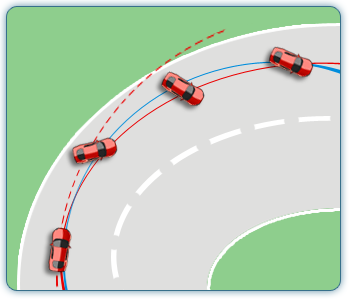What to Do If Your Car Skids
A vehicle skids when its tires lose their grip on the road surface. Most skids are caused by drivers traveling too fast for road conditions, like when a driver speeds down an icy street. Other times, skids are caused when a driver alters the vehicle’s direction or speed abruptly.
One example of this is when a driver sees a stop sign too late and slams on the brakes. Another example is when a driver takes a turn too quickly. A skid can also occur if a vehicle’s brakes lock during hard braking, or if a driver suddenly accelerates very quickly, particularly when starting from a stationary position. In short, any sudden change of speed or direction that results in a sudden redistribution of the car’s weight (forward or to one side), leads to skidding.
 Cornering Skid
Cornering Skid
Types of Skids
There are several types of skids your vehicle can experience:
- Braking Skid. Braking skids occur when you apply the brakes too forcefully. This can result in a 4-wheel lock where your car skids in the direction it is traveling or in a rear-wheel lock where the rear of your car begins to swing around to the front.
- Power Skid. A power skid occurs from sudden or hard acceleration.
- Cornering Skid. Cornering skids can happen when you suddenly or harshly accelerate on a curve. They can cause you to slide off the roadway or out of your lane.
- Blowout Skid. A blowout skid occurs when you lose control of your vehicle because a tire has blown out.
What to Do if Your Car Skids
If your car starts to skid, it is very important that you don’t slam on the brakes. Instead, take your foot off the gas pedal and the brake pedal.
If you experience a braking skid or a cornering skid, release the brake immediately and quickly steer the vehicle in the direction you want to go. Prepare to counter steer and then straighten the wheels. Do this gently—overcorrecting can cause your vehicle to spin out. Apply the brakes lightly once you have gotten control of the vehicle.
In the event of a power skid, release the accelerator pedal and steer to straighten the car. Prepare to counter steer and then straighten the wheels to get back on track.
Avoiding Skids
In most cases, you can avoid skids by driving the proper speed for road conditions. Slow down for poor weather and before making a turn. You should also keep your tires in good condition. Over time, tires lose their tread, making it difficult for them to keep traction on the road. Worn or underinflated tires are dangerous. Overinflated tires can be dangerous, too. Make sure your tires are ready for the road by checking them regularly.